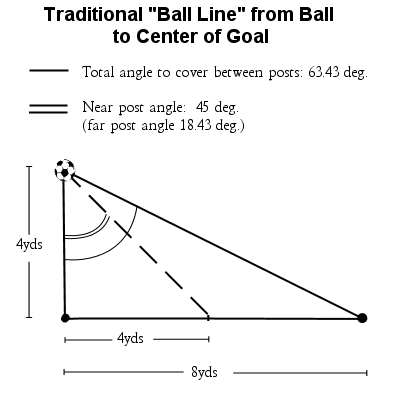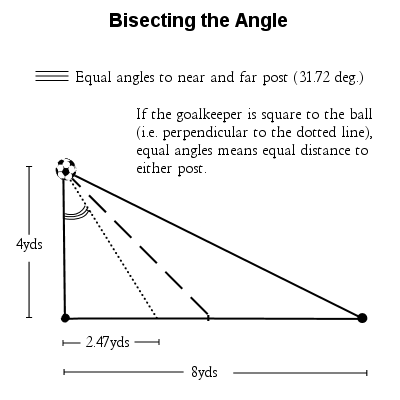
|
"Outstanding keeper instruction. This is a must for goalkeepers and coaches." —Ottawa Internationals S.C. web site, Ottawa, Canada |

|

|
Top |
Goalkeeping Tips, Tidbits and Random Thoughts
An athlete talking to themsleves during competition is hardly a new phenomenon.... The talk does not have to be vocal. By merely thinking you are talking to yourself and sending a message.
-- Tony DiCicco, Goalkeeper Soccer Training Manual
If you have a question, comment or rebuttal you'd like to see addressed here, send me email. I will post your mail to the blog at my discretion unless you specify otherwise.
The most common mistakes
What are the technical breakdowns that lead to the most goals given up by goalkepeers? Most people would probably say that the problem is with the hands when the keeper lets and easy one get through, or perhaps with the diving or parrying technique. I don't think so... in fact, I'd put "hands" third on the list of mistake-prone areas after these two:- Footwork. Many goals are allowed before the ball ever reaches the goalkeeper. With only split seconds to react, a keeper must be in the ready position before the shot is struck, if possible. It's hard to react and make a save when you are still moving. Footwork is also at fault for many diving and parrying miscues and for mishandled crosses—if the proper footwork isn't executed from the start, the resulting save will be much, much more difficult.
- Eyes. It's the simplest thing in the world: watch the ball all the way into your hands until it's secured. It's also the simplest thing to forget. Take your eye off the ball a second too soon to look upfield, or look at that charging forward instead of the soccer ball, and the ball could be in the net.
Labels: Catching, Footwork and positioning
Goalkeeping footwork in a nutshell
I recently got an email asking about footwork: what is it, really, and why is it important for goalkeepers?I sum up goalkeeping footwork in a nutshell: The easiest save to make is one where the ball is right in front of you and your body is behind it. Good footwork makes it so that, as much as possible, every shot is right in front of you and your body is behind the ball.
This applies even to flying saves and claiming crosses. If you look at proper form for both of these, the body is square to the ball, behind it, and in a good catching position. It's the footwork that gets the body there in the first place.
Labels: Footwork and positioning
Good habits
My entry on indoor play prompted several emails. I'll state for the record that a page on indoor goalkeeping is on my To Do list. There are lots of variations (with hockey-style boards, futsal, and all kinds of one-off configurations of pitch and goal sizes. I haven't played them all, but I will try to provide general pointers for small-sided games. It'll come eventually, but I wouldn't hold my breath.One writer says, "...it isn't always a bad thing to use your knees to save... like anything else, it is situational." This is certainly true. At the end of the day, your job is to keep the ball out of the net, and if you do that successfully very few will care how you did it. The writer says he plays indoor almost exclusively, and continues, "I find myself facing ALOT of close shots at full pace... sometimes, even in a good stance, the easiest way to make the save is to make a wall by dropping to my knees." Easy, yes. Best, probably not. There are lots of situations where you can take the easy way out, but it is far from the best technique (diving backwards comes to mind immediately). In a good stance, with feet staggered front-to-back keeping the five-hole closed, and hands low and wide, you should be able to stop just about any close-in shot without going to your knees, IMHO.
My other objection to this may not concern this correspondent if he doesn't play outdoors. Going to the knees indoors will develop bad habits for the 11v11 game outside. On a full field, where you have a larger goal to cover, going to your knees can put you in a bad situation in a hurry. Better to use techniques like the front smother that are more appropriate. Develop good stance and good habits that will serve you in any situation.
Labels: Footwork and positioning
No knees
One flaw I see in many young or inexperienced goalkeepers is the tendency to drop to their knees to make a save. In fact, the goalkeeper of the indoor team we played last night did this a lot. He almost played hockey-style. That might be okay for a small indoor goal, but even so I think it led at least indirectly to all three goals he gave up. Outdoors, of course, getting stuck on your knees can be a disaster. And poor technique can be dangerous not just to your goal, but to yourself.The keeper was athletic but technically poor. Just a few minutes into the game, he slid low to make a save. I went to jump over him, as soccer etiquette demands. But he "prairie dogged" on me and popped his head up and I just about took his noggin off. I tried to tell him, as he distributed the ball, what just happened and that if he went low, I'd go high, but I'm not sure he understood.
Then there was the knee business. On the three goals that I scored, he was on his knees before I took my final touch. That made him unable to move and react as well as he should have, and his armspan wasn't enough to cover the whole goal quickly enough.
In general, I find that going to your knees often is a sign of poor stance. Either your weight is back on your heels, you are too upright, or a combination of both. If you have your knees well bent and your weight forward, your hands should be in front and low where it's easy to collect the ball off the ground and stay on your feet. If it's a hard, turf-burning shot, a front smother is the recommended technique.
Labels: Footwork and positioning
Bisecting the angle
I spent some time discussing angle play with another coach, and looked over my previous entry on angles. I realized how using the "ball line" as a positioning tool breaks down once the ball gets close to goal.What we really want to do as goalkeepers is to take up a position that bisects the angle that needs to be covered, not one that bisects the goal line. When the ball gets close to goal and is not dead center, these two lines are quite different.
If you're mathematically inclined, you could probably do a general proof of this (knock yourself out!), but here's an example. We'll place the ball even with one of the goalposts so we can use right triangles and high-school trig. In the first diagram, the ball is even with the left post and 4 yards off the goal line. The goal is 8 yards wide, so here's the angles for the "traditional" ball line:

If you measure the angles this gives you, the angle to the near post is 63.43 degrees; the angle to the far post is only 18.43 degrees. We are obviously way too far towards the far post!
What we really want to do is to take up a position that bisects the total angle we have to cover. This position is indicated by the dotted line. If the keeper is square to the ball (in other words, perpendicular to the line of bisection), this means the keeper has an equal distance to cover either post:

Obviously, this covers the goal much better. It is shifted towards the near post significantly from the center of the goal.
Now, once the ball gets farther away from goal, or the ball is closer to the center of the goal, the difference between the two is very small and using the "ball line" as a starting point works just fine. Here's how the angles change if the ball is even with the left post but 16 yards out. The difference in angles is less than a degree, and a goalkeeper on the goal line needs to only adjust by 8 inches, or less if they're off the line:

So we can still use the ball line to the center of the goal as a guideline and starting point, but goalkeepers should learn to (and probably instinctively do anyway) split the angle they have to cover in two.
Labels: Footwork and positioning
Stance is critical
It is often overlooked, but the goalkeeper's stance is absolutely critical. I see many, many goalkeepers whose stance is too upright. Tony Waiters has a saying that a goalkeeper's stance should be more like a gorilla's than a marine's, and it's absolutely true. An upright stance brings a number of problems:- It becomes very difficult to get down to low shots.
- Related to the above, the goalkeeper is giving away the easiest shot for a striker to score on--the simple push pass right by the goalkeeper's feet.
- The goalkeeper is less balanced, making quick footwork more difficult.
- The keeper tends to lead with their feet.
- It is difficult to get power into dives and leaps.
Simply bending the knees and getting lower (while still keeping the head and shoulders up) will solve all of the above. For example, a low stance helps with both low dives and high dives. For low balls, if you start low it's easier to get to the ground quickly, and the hands are already down there to get to the ball first. For high balls, a low stance "pre-loads" the legs so the keeper gets a good push and power step to get the towards the crossbar.
Try working with your keepers on a lower stance than they usually use, and see how it helps!
Labels: Footwork and positioning
Nutmegged
Nutmegged. If letting the ball get poked between your legs is embarrassing for a field player, getting megged is tragic for a goalkeeper. But it does happen.In fact, it's happened twice recently to Poland and Liverpool keeper Jerzy Dudek. The first was last week, when DaMarcus Beasley scored the only goal in the USA's 1-0 victory over Poland. The second happened today, when Thierry Henry put one through Dudek in Arsenal's 4-2 win against Liverpool. Both goals looked similar: a through ball on the left side of the box, a player coming in alone, and a left-footed side-foot push on the ground into the net.
Good strikers wait for the goalkeeper to make a move, since they know that the keeper is vulnerable when not set. If the keeper compounds that by having a poor stance (Dudek was leaning back precariously on both goals) the attacker's job is that much easier.
So how do you prevent the meg? When approaching a player who is in the clear (essentially a breakaway situation), keep your weight forward in a good stance. Then, to prevent the gap between your legs, narrow your stance a bit and straddle your feet more front-to-back, with one foot ahead of the other, rather than wide side-to-side. A front-to-back stance will allow you to stay balanced and on your toes while preventing the 5-hole (as it's known in ice hockey) from opening up.
You can also use your hands. As you stalk the attacker, put your trailing hand in between your legs. Your leading hand stays wide and low in the direction the attacker is going.
Labels: Breakaways, Footwork and positioning
Do you know where your goal is?
It's the 90th minute. Do you know where your goal is?When it comes to positioning, everyone thinks about the obvious -- knowing the position of the ball. But what needs to come before that, that may not be quite so obvious, is that the goalkeeper must always know the position of the goal. May young and inexperienced keepers get caught ball watching, with the result that when they have to come out to challenge a breakaway or cut down the angle, they start from a poor position. That initial poor position just gets magnified as they get farther from goal.
A good goalkeeper takes a second to locate the goal whenever they have the opportunity -- near post first, since it's closer, then far post if there is enough time. Good times to check the posts are:
- When the ball crosses midfield heading towards the keeper
- Any time the ball is turned over and the opposition is heading towards the keeper, as long as a shot is not imminent
- When the attacker gets turned away from goal
- When the attacker is securely defended and there's no danger of a shot
- When the attacker is in poor shooting position (very wide at a sharp angle) and a shot is unlikely
- When the ball is travelling between players, especially on long flighted balls
Not only are these good times for the keeper to position themselves, but these same opportunities can be used to scan the field and see how the defense is organized and make adjustments, spot dangerous attackers and anticipate how play might develop.
Stand behind the goal during a game-like situation and watch your goalkeeper's eyes for a few minutes. Are they scanning the field, checking the goalposts, and taking everything in? Or are their eyes glued to the ball the whole time? Ball watching is a cardinal sin for any defender, but getting caught out of position because of ball watching is often a fatal mistake for a keeper.
For some more ideas and activities related to this, see this post on SoccerCoachingForum.com.
Labels: Footwork and positioning
The green flash
After watching my new U13 team of girls this weekend, I remain as firmly convinced as ever that footwork and positioning are keys to successful goalkeeping. In the second half of our semifinal match, we were a bit gassed and under pressure almost the entire time. We allowed 7 shots in the 35 minutes, 5 of them on frame, but my goalkeeper was in the proper position to field just about everything, only having to make one real sprawling save on a point-blank shot. She was very active, and never left her feet unless is was to pounce on a loose ball. She kept the clean sheet, and allowed us to get through overtime to penalty kicks, which we won when our opponents missed their last three kicks -- wide left, wide right, and over the bar. Certainly makes the keeper's job easier!Then, in the final, we were up against a superior team. But down 0-1 late in the first half, one of our attackers, a defender and the opposing goalkeeper all collided near the top of the area going for a through ball. With the keeper down on the ground, the ball squirted free to our right wing who took one touch and hammered a shot at the open net... when from out of nowhere came this green flash (that's the color of the jersey the keeper was wearing) to knock the ball wide with a desperate lunge. That was the play of the game -- instead of getting the equalizer, we stayed down a goal at half and ended up losing. What everyone saw was the dive, but in the second or two it took for the shot to happen, the goalkeeper had to untangle herself, get to her feet, and go about 15 yards just to be in a position to attempt the save. What no one noticed was the quickness and footwork that made the save even possible.
Labels: Footwork and positioning
Caught with your feet stuck
A reader writes: "My question is regarding the ready position. Often I find myself get caught with "my feet stuck in the ground" and don't react to a shot I know I could dive and save. Could you maybe have any idea of what I may be doing wrong or what I may have to do to keep this from happening?"Paradoxically, when you get "stuck" and can't react, it's often because your feet are moving, not stationary! If you're moving, one foot may not be in contact with the ground, limiting your ability to push off.
There are several things you can do to minimize this. First, use quick footwork to get yourself between the ball and the goal before the shot arrives. This will give you time to properly set yourself. Second, learn to time the shooter and come to the ready position just a bit earlier -- again, you want to be in the ready position before the ball leaves the shooter's foot. Finally, make sure that once you hit the ready position, you are balanced (not cheating to one side or the other) and on your toes with your weight forward.
Labels: Footwork and positioning
What is the proper near-post positioning?
Don't get beat near post. That's what all goalkeepers have heard at one time or another. Protect the near post. Why is that? A couple of reasons stick out: the near post is closer, so shots get there more quickly, and it is also an easier (closer) shot for the attacker if left open. But what is really the proper positioning to stop that near post shot?Tim Fiedler writes: "If the GK keeps himself in the line between the ball and the center of the goal, they will NOT cover the near and far post equally as well. As the ball moves towards one side of the field (or the other), there will be a greater angle open to the near post than the angle to the far post." Then referring to Fig. 2 on the positioning page: "Your diagram actually shows pretty much the proper position for equal coverage.".
Sure enough, the diagram splits the angle neatly in half, covering both sides of the goal, but the "keeper" in the diagram is not along the center line -- he is shifted near post! It turns out that when the ball is "close" to goal -- less than about 8 yards out -- and not dead center, the geometry is such that you do need to shift near post to get the proper angle. This shift gets less pronounced the closer to the center of the field the ball is, and the farther from goal it is. I think most goalkeepers instinctively make this shift, much like I probably did when drawing the diagram for the web site! (You can also use the Right Angle applet to demonstrate this clearly.)
So now we've got another reason to cheat near post. It's where you have to be to have the proper angle for some situations. It's such an old saw, and now that a little high school geometry proved it, I was curious what others said about it. DiCicco refers to the line between the ball and center of the goal as the "ball line", and says all movement should be along this line. No mention of shifting near post. Waiters and Luxbacher don't mention the "ball line" or covering the near post at all; they just talk about moving out to reduce the angle.
Here's my take on it. Being along the center line will put the keeper in good position for most shots, and you should still teach this to your goalkeepers. For beginning goalkeepers, I would probably not mention the near post shift -- they seem to adjust pretty well
naturally, and giving them an exception to the rule for some cases might just confuse them. I can see them cheating too far to the near post and giving up easy far post goals instead. It's a great point to make to more experienced keepers.
Labels: Footwork and positioning
The difference between a goal and a save
Hmmm, is it really an aphorism if I made it up myself? Merriam Webster defines it as "a concise statement of principle; a terse formulation of a truth". I guess all those old sayings have to start somewhere! I'm sure anyone who has coached for any period of time collects these sorts of sayings just like they collect drills and games.How about this one, from elsewhere on my site: "The difference between a goal and a save is a half-step." I often illustrate this by placing a ball just to the side of me on the ground, and reach out for it with only my hands between the ball and the goal. "This is a goal." There's nothing behind my hands; if they let me down, the ball is in the net. Then I take a small half-step so I'm directly behind the ball. "This is a save." I have an extra barrier between the ball and the goal, and make the save.
Labels: Footwork and positioning